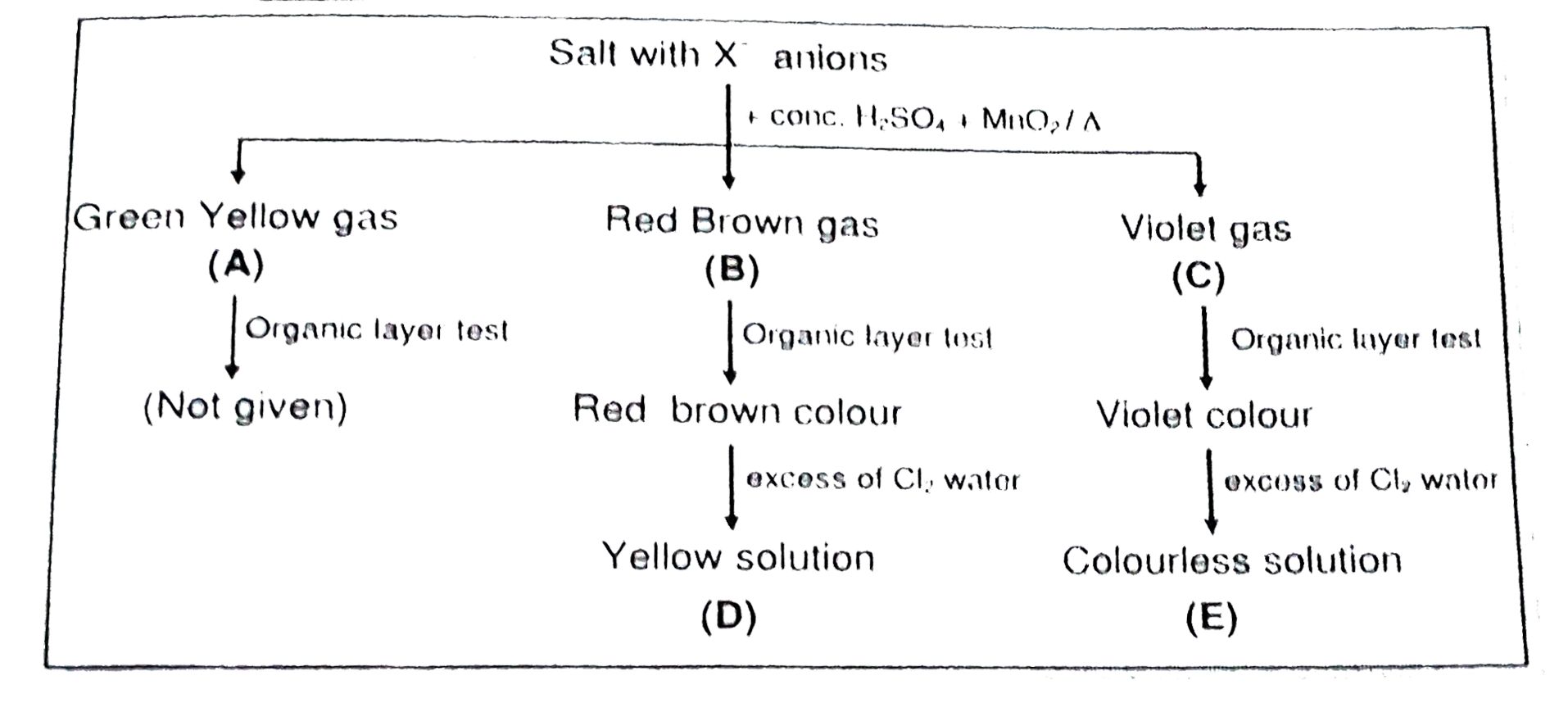Zinc on reaction with NaOH gives a salt (A) along with a gas (B).
(A) on reaction with gas gives a white precipitate (C ).
Identify (A), (B) and (C ).
To solve the given problem step by step, we will analyze the reactions involving zinc, sodium hydroxide, and hydrogen sulfide.
Step 1: Reaction of Zinc with Sodium Hydroxide
When zinc reacts with sodium hydroxide (NaOH), it forms a salt and releases a gas. The chemical equation for this reaction is:
Zn+2NaOH→Na2ZnO2+H2
Here, the salt formed is sodium zincate (Na2ZnO2) and the gas released is hydrogen (H2).
Step 2: Identify A and B
From the reaction above:
- A (the salt) = Sodium Zincate (Na2ZnO2)
- B (the gas) = Hydrogen (H2)
Step 3: Reaction of Sodium Zincate with Hydrogen Sulfide
Next, we need to consider what happens when sodium zincate reacts with hydrogen sulfide (H2S). The reaction can be represented as:
Na2ZnO2+H2S→ZnS+2NaOH
In this reaction, zinc sulfide (ZnS) is formed, which is known to produce a white precipitate.
Step 4: Identify C
From the reaction above, we identify:
- C (the white precipitate) = Zinc Sulfide (ZnS)
Summary of Identifications
- A = Sodium Zincate (Na2ZnO2)
- B = Hydrogen (H2)
- C = Zinc Sulfide (ZnS)
Final Answer
- A = Sodium Zincate (Na2ZnO2)
- B = Hydrogen (H2)
- C = Zinc Sulfide (ZnS)
---
When zinc reacts with sodium hydroxide (NaOH), it forms a salt and releases a gas. The chemical equation for this reaction is:
From the reaction above:
- A (the salt) = Sodium Zincate (Na2ZnO2)
- B (the gas) = Hydrogen (H2)
Next, we need to consider what happens when sodium zincate reacts with hydrogen sulfide (H2S). The reaction can be represented as:
From the reaction above, we identify:
- C (the white precipitate) = Zinc Sulfide (ZnS)
- A = Sodium Zincate (Na2ZnO2)
- B = Hydrogen (H2)
- C = Zinc Sulfide (ZnS)
- A = Sodium Zincate (Na2ZnO2)
- B = Hydrogen (H2)
- C = Zinc Sulfide (ZnS)
Topper's Solved these Questions
- S-BLOCK GROUP 1 - ALKALI METALSBOOK - CENGAGE CHEMISTRY ENGLISHCHAPTER - S-BLOCK GROUP 1 - ALKALI METALSEXERCISE - Ex 4.1 (Subjective)
24 Videos
- S-BLOCK GROUP 1 - ALKALI METALSBOOK - CENGAGE CHEMISTRY ENGLISHCHAPTER - S-BLOCK GROUP 1 - ALKALI METALSEXERCISE - Ex 4.1 (True/False)
1 Videos
- S-BLOCK GROUP 1 - ALKALI METALSBOOK - CENGAGE CHEMISTRY ENGLISHCHAPTER - S-BLOCK GROUP 1 - ALKALI METALSEXERCISE - Archives Subjective
8 Videos
- REDOX REACTIONSBOOK - CENGAGE CHEMISTRY ENGLISHCHAPTER - REDOX REACTIONSEXERCISE - Archives (Integers)
1 Videos
- S-BLOCK GROUP 2 - ALKALINE EARTH METALSBOOK - CENGAGE CHEMISTRY ENGLISHCHAPTER - S-BLOCK GROUP 2 - ALKALINE EARTH METALSEXERCISE - Ex 5.1 Objective
2 Videos
Similar Questions

Identify the gas A, B and C.
View SolutionOixalic acid on stragheating gives (A) and (B) which are gaseous prouct and ( C) which is a liwue . Gas (B) turns lime water miky. Gas (A) on reaction with chlorine gas gives (D) . (D)m as wll as (B) on heating with ammonia gas gives the same produce ( E) . Identify (A) ,(B), ( C), (D) and ( E).
View SolutionSilver nitrate on reaction with potassium chloride gives white precipitate of
View SolutionAn organic compound A’ with molecular formula C7H7NO reacts with Br2/aqKOH to give compound B’, which upon reaction with NaNO2&HCl at O∘C gives C’. Compound C’ on heating with CH3CH2OH gives a hydrocarbon D’. Compound B’ on further reaction with Br2 water gives white precipitate of compound E’. Identify the compound A, B, C, D&E, also justify your answer by giving relevant chemical equations.
View SolutionWhen a brown compound of manganese (A) is treated with HCl it gives a gas (B). The gas taken in excess, reacts with NH3 to give an explosive compound (C ). Identify compound A, B and C.
View SolutionCaCO3 on heating gives a white solid (A) and a gas (B), (A) on heating with carbon gives a solid (C) and a gas (D), (C) on hydrolysis glves a gas (E) and a solid (F) Identify (A), (B), (C), (D) , (E) and (F) .
View SolutionMagnesium on heating in air gives (A) and (B). On reaction with water (B) gives a colourless gas (C).(C) when passed through CuSO4 solution, gives a blue coloured solution (D). Identify (C)
and (D).
View SolutionCompound (A), C8H6NOBr, is optically active. Reduction of (A) gives (B) which reacts with nitrouos acid to form (C), dihydric alcohol. Benzene sulphonyl chloride reacts with (B) to give a product soluble in NaOH. Hydrolysis of (A) gives (D) which is an optically active acid. (A) does not give any precipitate with aqueous AgNO3 . Controlled oxidation of (A) gives monobromo benzoic acid. Compound (A) on reaction with Br2/Fe gives only one compound. Identify (A), (B), (C), and (D).
View SolutionBoron reacts with oxygen at 700∘C to give (A). Compound (A) reacts with carbon and dry chloride to give (B) and carbon monoxide. (B) on reduction with LiAlH4 gives (C) along with LiCl and AlCl3.(C) on reaction with ammonia gives (D). Which on heating gives (E).(C) on reaction with NaH gives (F).
Compound (A) is
View SolutionThe reaction of slaked lime with Cl2 gas gives
View Solution
